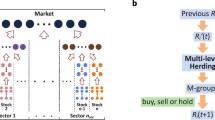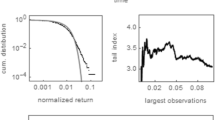Abstract
We introduce a minimal agent based model for financial markets to understand the nature and self-organization of the stylized facts. The model is minimal in the sense that we try to identify the essential ingredients to reproduce the most important deviations of price time series from a random walk behavior. We focus on four essential ingredients: fundamentalist agents which tend to stabilize the market; chartist agents which induce destabilization; analysis of price behavior for the two strategies; herding behavior which governs the possibility of changing strategy. Bubbles and crashes correspond to situations dominated by chartists, while fundamentalists provide a long time stability (on average). The stylized facts are shown to correspond to an intermittent behavior which occurs only for a finite value of the number of agents N. Therefore they correspond to finite size effects which, however, can occur at different time scales. We propose a new mechanism for the self-organization of this state which is linked to the existence of a threshold for the agents to be active or not active. The feedback between price fluctuations and number of active agents represents a crucial element for this state of self-organized intermittency. The model can be easily generalized to consider more realistic variants.
Similar content being viewed by others
References
L. Bachelier, Ph.D. thesis, Annales Scientifiques de l’École Normale Supérieure (1900)
R. Cont, Quant. Finance 1, 223 (2001)
R.N. Mantegna, H. Stanley, An Introduction to Econophysics: Correlation and Complexity in Finance (Cambridge University Press, New York, NY, USA, 2000)
J.P. Bouchaud, M. Potters, Theory of Financial Risk and Derivative Pricing: From Statistical Physics to Risk Management (Cambridge University Press, 2003)
B. Mandelbrot, J. Business 36, 394 (1963)
B. Mandelbrot, Fractals and Scaling in Finance (Springer Verlag, New York, 1997)
R. Engle, Econometrica 50, 987 (1982)
C. Tsallis, C. Anteneodo, L. Borland, R. Osorio, Physica A 324, 89 (2003)
L. Borland, Phys. Rev. Lett. 89, 098701 (2002)
F. Baldovin, A. Stella, PNAS 104, 19741 (2007)
B. LeBaron, in Medium Econometrische Toepassingen (MET) (Erasmus University, 2006)
V. Alfi, L. Pietronero, A. Zaccaria, e-print arXiv:0807.1888 (2008)
V. Alfi, M. Cristelli, L. Pietronero, A. Zaccaria, Eur. Phys. J. B, DOI: 10.1140/epjb/e2009-00029-3
T. Lux, M. Marchesi, Nature 397, 498 (1999)
T. Lux, M. Marchesi, International Journal of Theoretical and Applied Finance 3, 675 (2000)
G. Vaglica, F. Lillo, E. Moro, N. Mantegna, Phys. Rev. E 77, 036110 (2008)
M. Takayasu, T. Mizuno, H. Takayasu, Physica A 370, 91 (2006)
T. Mizuno, H. Takayasu, M. Takayasu, Physica A 382, 187 (2007)
V. Alfi, F. Coccetti, M. Marotta, L. Pietronero, M. Takayasu, Physica A 370, 30 (2006)
V. Alfi, A. De Martino, A. Tedeschi, L. Pietronero, Physica A 382, 1 (2007)
A. Kirman, Quart. J. Econ. 180, 137 (1993)
M. Kreps, A Course in Microeconomic Theory (Princeton University Press, 1990)
S. Alfarano, T. Lux, F. Wagner, Journal of Economic Dynamics & Control 32, 101 (2008)
S. Alfarano, T. Lux, F. Wagner, Comput. Econ. 26, 19 (2005)
C. Gardiner, Handbook of stochastic methods: for physics, chemistry and the natural sciences (Springer, Berlin, 1990)
E. Egenter, T. Lux, D. Stauffer, Physica A 268, 250 (1999)
T. Bollerslev, J. Econometrics 31, 307 (1986)
T.A. Witten, L.M. Sander, Phys. Rev. Lett. 47, 1400 (1981)
L. Niemeyer, L. Pietronero, H.J. Wiesmann, Phys. Rev. Lett. 52, 1033 (1984)
P. Bak, C. Tang, K. Wiesenfeld, Phys. Rev. Lett. 59, 381 (1987)
H. Jensen, Self-organized criticality (Cambridge University Press, Cambridge, 1998)
P. Bak, How Nature Works: The Science of Self-Organised Criticality (Copernicus Press, New York, 1996)
Author information
Authors and Affiliations
Corresponding author
Rights and permissions
About this article
Cite this article
Alfi, V., Cristelli, M., Pietronero, L. et al. Minimal agent based model for financial markets I. Eur. Phys. J. B 67, 385–397 (2009). https://doi.org/10.1140/epjb/e2009-00028-4
Received:
Revised:
Published:
Issue Date:
DOI: https://doi.org/10.1140/epjb/e2009-00028-4




